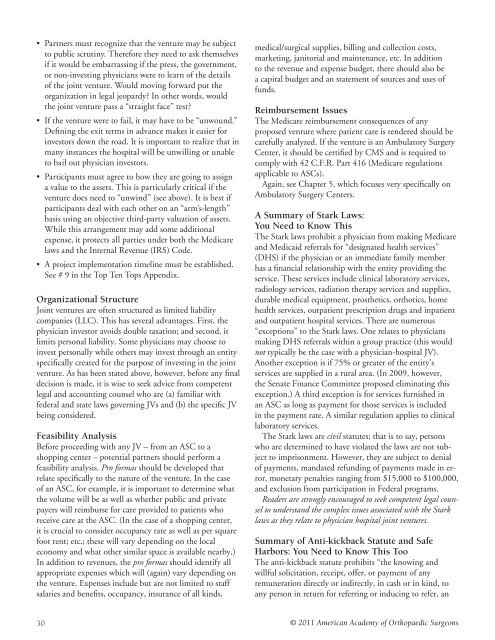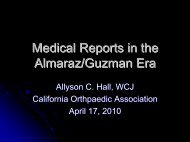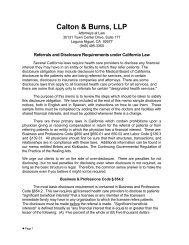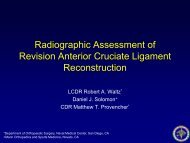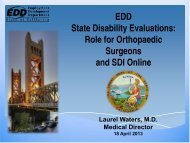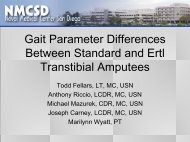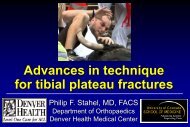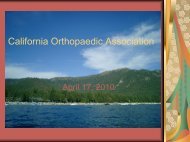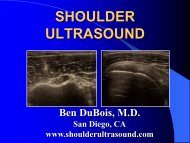Enhancing Your Practice's Revenue - California Orthopaedic ...
Enhancing Your Practice's Revenue - California Orthopaedic ...
Enhancing Your Practice's Revenue - California Orthopaedic ...
- No tags were found...
You also want an ePaper? Increase the reach of your titles
YUMPU automatically turns print PDFs into web optimized ePapers that Google loves.
• Partners must recognize that the venture may be subjectto public scrutiny. Therefore they need to ask themselvesif it would be embarrassing if the press, the government,or non-investing physicians were to learn of the detailsof the joint venture. Would moving forward put theorganization in legal jeopardy? In other words, wouldthe joint venture pass a “straight face” test?• If the venture were to fail, it may have to be “unwound.”Defining the exit terms in advance makes it easier forinvestors down the road. It is important to realize that inmany instances the hospital will be unwilling or unableto bail out physician investors.• Participants must agree to how they are going to assigna value to the assets. This is particularly critical if theventure does need to “unwind” (see above). It is best ifparticipants deal with each other on an “arm’s-length”basis using an objective third-party valuation of assets.While this arrangement may add some additionalexpense, it protects all parties under both the Medicarelaws and the Internal <strong>Revenue</strong> (IRS) Code.• A project implementation timeline must be established.See # 9 in the Top Ten Tops Appendix.Organizational StructureJoint ventures are often structured as limited liabilitycompanies (LLC). This has several advantages. First, thephysician investor avoids double taxation; and second, itlimits personal liability. Some physicians may choose toinvest personally while others may invest through an entityspecifically created for the purpose of investing in the jointventure. As has been stated above, however, before any finaldecision is made, it is wise to seek advice from competentlegal and accounting counsel who are (a) familiar withfederal and state laws governing JVs and (b) the specific JVbeing considered.Feasibility AnalysisBefore proceeding with any JV – from an ASC to ashopping center – potential partners should perform afeasibility analysis. Pro formas should be developed thatrelate specifically to the nature of the venture. In the caseof an ASC, for example, it is important to determine whatthe volume will be as well as whether public and privatepayers will reimburse for care provided to patients whoreceive care at the ASC. (In the case of a shopping center,it is crucial to consider occupancy rate as well as per squarefoot rent; etc.; these will vary depending on the localeconomy and what other similar space is available nearby.)In addition to revenues, the pro formas should identify allappropriate expenses which will (again) vary depending onthe venture. Expenses include but are not limited to staffsalaries and benefits, occupancy, insurance of all kinds,medical/surgical supplies, billing and collection costs,marketing, janitorial and maintenance, etc. In additionto the revenue and expense budget, there should also bea capital budget and an statement of sources and uses offunds.Reimbursement IssuesThe Medicare reimbursement consequences of anyproposed venture where patient care is rendered should becarefully analyzed. If the venture is an Ambulatory SurgeryCenter, it should be certified by CMS and is required tocomply with 42 C.F.R. Part 416 (Medicare regulationsapplicable to ASCs).Again, see Chapter 5, which focuses very specifically onAmbulatory Surgery Centers.A Summary of Stark Laws:You Need to Know ThisThe Stark laws prohibit a physician from making Medicareand Medicaid referrals for “designated health services”(DHS) if the physician or an immediate family memberhas a financial relationship with the entity providing theservice. These services include clinical laboratory services,radiology services, radiation therapy services and supplies,durable medical equipment, prosthetics, orthotics, homehealth services, outpatient prescription drugs and inpatientand outpatient hospital services. There are numerous“exceptions” to the Stark laws. One relates to physiciansmaking DHS referrals within a group practice (this wouldnot typically be the case with a physician-hospital JV).Another exception is if 75% or greater of the entity’sservices are supplied in a rural area. (In 2009, however,the Senate Finance Committee proposed eliminating thisexception.) A third exception is for services furnished inan ASC as long as payment for those services is includedin the payment rate. A similar regulation applies to clinicallaboratory services.The Stark laws are civil statutes; that is to say, personswho are determined to have violated the laws are not subjectto imprisonment. However, they are subject to denialof payments, mandated refunding of payments made in error,monetary penalties ranging from $15,000 to $100,000,and exclusion from participation in Federal programs.Readers are strongly encouraged to seek competent legal counselto understand the complex issues associated with the Starklaws as they relate to physician hospital joint ventures.Summary of Anti-kickback Statute and SafeHarbors: You Need to Know This TooThe anti-kickback statute prohibits “the knowing andwillful solicitation, receipt, offer, or payment of anyremuneration directly or indirectly, in cash or in kind, toany person in return for referring or inducing to refer, an30© 2011 American Academy of <strong>Orthopaedic</strong> Surgeons


